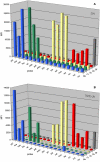Development and comparison of two assay formats for parallel detection of four biothreat pathogens by using suspension microarrays
- PMID: 22355407
- PMCID: PMC3280232
- DOI: 10.1371/journal.pone.0031958
Development and comparison of two assay formats for parallel detection of four biothreat pathogens by using suspension microarrays
Abstract
Microarrays provide a powerful analytical tool for the simultaneous detection of multiple pathogens. We developed diagnostic suspension microarrays for sensitive and specific detection of the biothreat pathogens Bacillus anthracis, Yersinia pestis, Francisella tularensis and Coxiella burnetii. Two assay chemistries for amplification and labeling were developed, one method using direct hybridization and the other using target-specific primer extension, combined with hybridization to universal arrays. Asymmetric PCR products for both assay chemistries were produced by using a multiplex asymmetric PCR amplifying 16 DNA signatures (16-plex). The performances of both assay chemistries were compared and their advantages and disadvantages are discussed. The developed microarrays detected multiple signature sequences and an internal control which made it possible to confidently identify the targeted pathogens and assess their virulence potential. The microarrays were highly specific and detected various strains of the targeted pathogens. Detection limits for the different pathogen signatures were similar or slightly higher compared to real-time PCR. Probit analysis showed that even a few genomic copies could be detected with 95% confidence. The microarrays detected DNA from different pathogens mixed in different ratios and from spiked or naturally contaminated samples. The assays that were developed have a potential for application in surveillance and diagnostics.
Conflict of interest statement
Figures



Similar articles
-
[Development of a universal primers PCR-coupled liquid bead array to detect biothreat bacteria].Zhonghua Yu Fang Yi Xue Za Zhi. 2009 Oct;43(10):890-4. Zhonghua Yu Fang Yi Xue Za Zhi. 2009. PMID: 20137470 Chinese.
-
Rapid focused sequencing: a multiplexed assay for simultaneous detection and strain typing of Bacillus anthracis, Francisella tularensis, and Yersinia pestis.PLoS One. 2013;8(2):e56093. doi: 10.1371/journal.pone.0056093. Epub 2013 Feb 13. PLoS One. 2013. PMID: 23418519 Free PMC article.
-
[Development of a multiplex PCR-suspension array for simultaneous detection of five bioterrorism bacteria].Sichuan Da Xue Xue Bao Yi Xue Ban. 2009 Mar;40(2):325-9. Sichuan Da Xue Xue Bao Yi Xue Ban. 2009. PMID: 19462919 Chinese.
-
Bacillus anthracis, Francisella tularensis and Yersinia pestis. The most important bacterial warfare agents - review.Folia Microbiol (Praha). 2009;54(4):263-72. doi: 10.1007/s12223-009-0046-1. Epub 2009 Oct 14. Folia Microbiol (Praha). 2009. PMID: 19826916 Review.
-
[Bacillus anthracis, prions, Coxiella burnetii].Rinsho Byori. 2002 Nov;Suppl 123:79-87. Rinsho Byori. 2002. PMID: 12652794 Review. Japanese.
Cited by
-
Development of multiplexed bead arrays for the simultaneous detection of nucleic acid from multiple viruses in bat samples.J Virol Methods. 2015 Oct;223:5-12. doi: 10.1016/j.jviromet.2015.07.004. Epub 2015 Jul 17. J Virol Methods. 2015. PMID: 26190638 Free PMC article.
-
Influence of the length of target DNA overhang proximal to the array surface on discrimination of single-base mismatches on a 25-mer oligonucleotide array.BMC Res Notes. 2014 Apr 17;7:251. doi: 10.1186/1756-0500-7-251. BMC Res Notes. 2014. PMID: 24742004 Free PMC article.
-
Simultaneous quantification of multiple bacteria by the BactoChip microarray designed to target species-specific marker genes.PLoS One. 2013;8(2):e55764. doi: 10.1371/journal.pone.0055764. Epub 2013 Feb 11. PLoS One. 2013. PMID: 23409037 Free PMC article.
-
Multiplex qPCR for reliable detection and differentiation of Burkholderia mallei and Burkholderia pseudomallei.BMC Infect Dis. 2013 Feb 14;13:86. doi: 10.1186/1471-2334-13-86. BMC Infect Dis. 2013. PMID: 23409683 Free PMC article.
-
Microsphere suspension array assays for detection and differentiation of Hendra and Nipah viruses.Biomed Res Int. 2013;2013:289295. doi: 10.1155/2013/289295. Epub 2013 Feb 6. Biomed Res Int. 2013. PMID: 23509705 Free PMC article.
References
-
- Cirino NM, Musser KA, Egan C. Multiplex diagnostic platforms for detection of biothreat agents. Expert Review of Molecular Diagnostics. 2004;4:841–857. - PubMed
Publication types
MeSH terms
Substances
LinkOut - more resources
Full Text Sources
Other Literature Sources
Molecular Biology Databases

